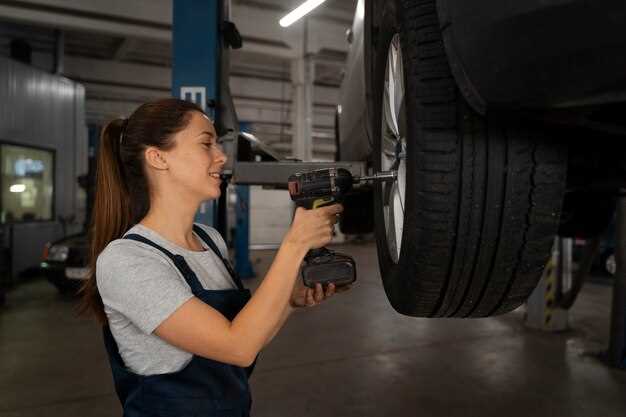
Proper wheel alignment is essential for the smooth operation and longevity of your vehicle. When your wheels are not aligned correctly, it can lead to uneven tire wear, compromised handling, and decreased fuel efficiency. Recognizing the early signs that your vehicle needs a wheel alignment can save you time and money, ensuring a safer driving experience.
One of the most common indicators that your vehicle requires a wheel alignment is uneven tire wear. If you notice that the tread on your tires is wearing unevenly or more quickly on one side, it may be a sign that your wheels are misaligned. Additionally, vibration in the steering wheel while driving can also suggest an alignment issue, as misalignment can cause the steering components to work harder than they should.
Furthermore, if your vehicle tends to drift or pull to one side while driving on a straight road, it’s a clear warning sign that your alignment may be off. This issue not only affects your comfort but also compromises your safety. Understanding these signs is crucial to maintaining optimal vehicle performance and ensuring a smooth ride.
Uneven Tire Wear Patterns and Their Implications
Uneven tire wear is a clear indicator that your vehicle may require a wheel alignment. Recognizing the specific patterns of wear can help diagnose underlying issues and prevent further damage.
- Cupping: This pattern appears as a wavy, scalloped outline along the tire’s surface. It often indicates that the suspension is not properly aligned or that there are issues with the shocks or struts. Addressing these problems promptly can enhance ride quality and tire longevity.
- Inner or Outer Edge Wear: When the inner or outer edges of the tire show excessive wear, it typically points to improper camber alignment. If the wear is more pronounced on the inner edge, it may suggest excessive negative camber, while outer edge wear often indicates positive camber issues. Regular check-ups can help rectify this condition.
- Center Wear: Tires that wear more in the center than on the edges often signal over-inflation. An over-inflated tire can lead to a harsher ride and reduced tire grip, especially in wet conditions. Monitoring tire pressure regularly can help mitigate this issue.
- Patchy Wear: This involves irregular patches of wear across the tire. It may signal a combination of alignment issues and improper tire pressure. This pattern can lead to decreased traction and should not be ignored.
Addressing uneven tire wear through proper wheel alignment can improve fuel efficiency, enhance safety, and prolong the lifespan of both tires and suspension components. Regular tire inspections and alignment checks are crucial to ensure your vehicle operates smoothly and safely.
Steering Wheel Off-Center: What It Means
An off-center steering wheel is a common sign that your vehicle may need a wheel alignment. When the steering wheel is not aligned with the vehicle’s straight path, it can indicate that the wheels are not positioned correctly relative to each other or the suspension system. This misalignment can lead to uneven tire wear, reduced handling capability, and increased strain on suspension components.
The primary reason for an off-center steering wheel is often a change in the vehicle’s wheel angles due to impacts from potholes, curbs, or accidents. These events can throw the wheels out of alignment, resulting in the steering wheel being off-center even when driving in a straight line. It is essential to address this issue promptly to maintain optimal driving performance and safety.
Additionally, an off-center steering wheel can make it challenging to control the vehicle, leading to an unsafe driving experience. It can cause one side of the car to drift or pull to one side, requiring the driver to constantly adjust their steering inputs to stay on course. This not only creates discomfort but also increases the risk of accidents.
If you notice your steering wheel is off-center, it is advisable to have your vehicle inspected by a qualified technician. They can assess the alignment of the wheels and determine whether a realignment or additional repairs are necessary. Regular alignment checks can prevent further complications and extend the lifespan of your tires and suspension components.
Vehicle Pulling to One Side: Causes and Consequences

One of the most common signs that your vehicle may require a wheel alignment is when it pulls to one side while driving. This issue can stem from several causes, which can significantly affect your vehicle’s performance and safety.
One primary cause of a vehicle pulling to one side is uneven tire pressure. If one tire is under-inflated compared to the others, it can create a discrepancy that leads to pulling. Additionally, worn or damaged tires can also contribute to this problem. Tires that have uneven tread wear or significant damage on one side can cause the vehicle to veer towards the affected side.
Another significant factor is improper wheel alignment due to impacts or adjustments. Hitting potholes, curbs, or any other road obstacles can throw off the alignment of your wheels. Misalignment can lead to uneven tire wear, reduced fuel efficiency, and compromised handling.
Suspension issues may also cause a vehicle to pull to one side. Components such as control arms, bushings, and ball joints are vital for maintaining proper wheel positioning. Any damage or wear to these parts can lead to misalignment, making it crucial to inspect the suspension regularly.
The consequences of ignoring a vehicle that pulls to one side can be severe. Aside from increased tire wear, which leads to premature tire replacement, pulling can also affect steering precision and overall vehicle stability. This can pose a significant safety risk, especially in emergency maneuvers or adverse weather conditions.
In summary, if your vehicle consistently pulls to one side, it is essential to investigate the underlying causes. Addressing issues such as tire pressure, tire condition, wheel alignment, and suspension integrity will not only enhance driving comfort but also ensure your safety on the road.
Vibrations in the Steering Wheel: When to Be Concerned
Experiencing vibrations in the steering wheel can indicate various underlying issues with your vehicle’s alignment or suspension system. When these vibrations occur, it is crucial to identify their cause to ensure your safety on the road.
If the vibrations are felt primarily at certain speeds, especially at higher velocities, it might signal an imbalance in the wheels or misalignment. This can lead to uneven tire wear and affect handling, making it necessary to address the problem promptly.
Moreover, if the vibrations worsen as you accelerate, it could point to issues with your tires such as damage, uneven wear, or even a bent rim. In contrast, if the vibrations are more pronounced when braking, this may indicate warped brake rotors rather than alignment issues.
Another factor to consider is the frequency of the vibrations. Continuous or persistent vibrations should not be ignored, as they may imply structural damages or defects in components like the suspension or steering system. It is advisable to consult with a professional mechanic to diagnose the issue correctly.
In summary, vibrations in the steering wheel are a sign that something may be amiss with your vehicle. Ignoring these symptoms can lead to more serious problems, so timely assessment and maintenance are essential for safe driving.
Feeling Loose or Wobbly Steering: Critical Indicators
A vehicle’s steering system is crucial for safe driving. When you experience loose or wobbly steering, it’s a significant warning sign that your vehicle may need a wheel alignment. This issue can arise from various factors, including worn suspension components or improper tire pressures, leading to unsafe driving conditions.
1. Instability While Driving: If your car feels unstable or sways when going over bumps, it indicates that alignment issues might be present. A properly aligned vehicle should maintain stability, allowing for smooth navigation on different road surfaces.
2. Excessive Steering Play: When you notice that the steering wheel has excessive play or feels disconnected, it can signal misalignment. You may find that steering requires more effort than usual, which can compromise your control over the vehicle.
3. Uneven Tire Wear: Check your tires for uneven wear patterns. If the inner or outer edges of the tires appear more worn than the center, this often indicates misalignment. Addressing this issue promptly can prevent further damage to your tires.
4. Pulling to One Side: If your car drifts to one side even when the steering wheel is straight, this is a clear indicator of alignment problems. The vehicle should track straight without requiring constant correction from the driver.
5. Vibration in the Steering Wheel: Unusual vibrations can be a result of misalignment, often experienced at higher speeds. If you feel persistent vibrations while driving, it’s essential to evaluate your wheel alignment and related components.
Addressing loose or wobbly steering promptly is vital for your safety and that of others on the road. If you notice any of these indicators, it’s advisable to seek a professional assessment of your vehicle’s alignment.
Impact of Misalignment on Fuel Efficiency: Understanding the Link
Misalignment of a vehicle’s wheels can significantly affect its fuel efficiency. When wheels are not properly aligned, they tend to drag against the road rather than roll smoothly. This drag creates additional resistance that the engine must overcome, resulting in increased fuel consumption. The misalignment leads to uneven tire wear, which further exacerbates the problem, as tires lose their optimal grip and traction.
Proper wheel alignment ensures that all four tires are positioned at the correct angles, allowing for efficient handling and minimizing frictional losses. When alignment is off, drivers may notice that their vehicle pulls slightly to one side, forcing them to exert more effort on the steering wheel, which can also lead to additional fuel use over time.
According to studies, misaligned wheels can decrease fuel efficiency by as much as 10%. This means that regular checks on wheel alignment not only enhance driving safety and comfort but also can lead to substantial savings on fuel costs. Staying on top of alignment issues can positively influence the longevity of tires, enhancing overall vehicle performance and reducing the frequency of costly replacements.
In essence, addressing misalignment promptly ensures that a vehicle operates efficiently, ultimately conserving fuel and reducing environmental impact. Regular maintenance of wheel alignment should be part of a comprehensive vehicle care routine to maximize both performance and fuel economy.














